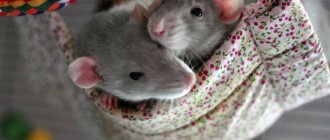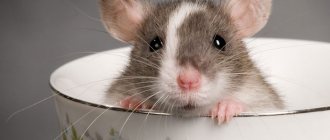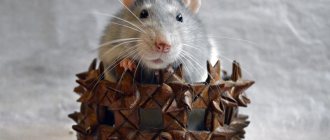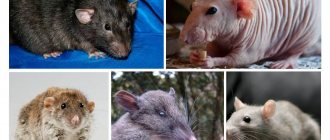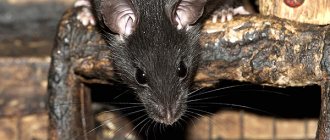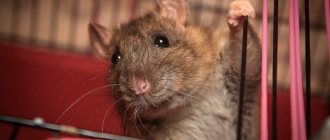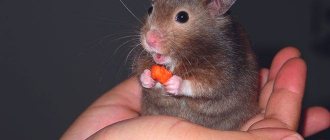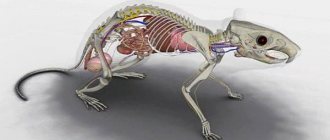The mouse family includes 1,700 species of rodents. Statistics show that for every person on our planet there are 2 rats. These animals, which appeared on Earth much earlier than humans, are among the most common today.
You need to know everything about rats, because the animals pose a serious danger: they eat useful crops in the fields, ruin food supplies, and carry dangerous infections.
Sometimes rodents attack humans, damaging tissues, infecting them with serious diseases, and provoking the development of psychological problems.
Lifespan depending on breed
Compared to other four-legged friends, domestic rats do not live long - on average from 1.5 to 2 years. However, under favorable conditions, the pet can reach an advanced age - about 4 years.
The main factor influencing the life span of a rat is heredity. Therefore, when choosing a pet, you need to consider the breed:
- The Sphynx is one of the most vulnerable species. The animals are hairless and are also endowed with many genetic diseases from birth. Therefore, most of them die at the age of 2 years. Moreover, obvious health problems begin at the age of 1.5 years.
- White - like any albinos in the animal world, representatives of this breed are also not distinguished by good health. They die on average at the age of 2 years, provided that the pet was well cared for.
- Dumbo, satin, rex are artificially created breeds. Breeders took care to minimize hereditary pathologies. Therefore, decorative rats have relatively good health. And with proper care they can easily live up to 3 years.
- Fuzz are small rats with slightly curling whiskers and fur. Representatives of this breed are considered long-lived. On average, a healthy individual lives up to 3.5 years.
The Guinness Book of Records includes a domestic rat that lived to be 7 years old. At the same time, the pet owner claims that the secret of the rodent’s longevity is that the animal lived in love and harmony with all family members.
Decorative breeds of rats
Decorative rats
For pet lovers, it will be interesting to know what breeds exist, how to feed and care for them, what diseases they suffer from, and how many years rats live.
- Sphynxes (hairless) are one of the modern domestic breeds bred through mutation. Her well-being and longevity are affected not only by nutrition, but also by problems associated with heating - the optimal temperature regime is + 16-30ºС, as well as treatment of colds, skin, allergic diseases, inflammatory processes in the genitourinary system, which are common in this breed of various types of tumors, incl. malignant.
- White rats: there are individuals with regular and red eyes, they are distinguished by their attractive appearance and great affection for their owner, friendly character, and are easy to train. Basic diet: cereals, vegetables and fruits, protein foods - raw and cooked meat and vitamins, clean water is required. However, this domestic species is characterized by reduced immunity: they can easily catch colds and are susceptible to infections, which is why their life cycle ends in 1.5-2 years.
- The most aristocratic species is the blue rat, whose representatives are loyal and intelligent friends of humans, are able to remember words, love to play, have a non-aggressive character, and live 2-2.5 years.
- Less whimsical types of domestic rats: Rex, Dumbo, etc. Animals are very fond of cleanliness and order in their home, various toys and entertainment. Riding on a wheel will help such a rodent stay fit and get sick less. Obesity in all breeds of rats can lead to heart disease and other diseases, which will reduce their life expectancy.
Why do rats die at home?
The rat is a fairly active animal, constantly exploring the surrounding space, tasting new objects. Therefore, rodents often die prematurely due to the carelessness of the owners who did not protect the pet from potential dangers. The causes of early death of domestic rats are often:
- injuries received from other pets (cats or dogs);
- eating plants dangerous to rats (geranium, aloe, tulip, daffodil, dieffenbachia);
- chewing electrical wires;
- falling out of a window or balcony;
- great fear.
Also, rat owners often inadvertently step on or sit on the animals. Fluffies are very nimble and easy to miss, especially in the evening and at night. Therefore, in order to avoid troubles, it is necessary to organize a safe walk for them in a fenced area. The rest of the time, the pet rat should be kept in a tightly locked cage.
Why are rats dangerous?
Rodents that live near humans not only damage property and eat food supplies, but also spread more than 80 dangerous diseases. They are found in places where there is unsanitary conditions: abandoned buildings, landfills, basements. The animals are not susceptible to human diseases; they transmit infections through contact, bites, droppings or exhaled air.
Regardless of the breed, all these mammals pose a danger to humans, since they carry a large number of fungi, pathogenic microbes, and bacteria every day.
The most common diseases include:
- plague;
- fever;
- typhus; encephalitis;
- giardiasis;
- rabies;
- tuberculosis;
- toxoplasmosis;
- hepatitis;
- viruses, fungi, parasitic pathologies.
Animal excrement contains substances that cause allergies, lead to the development of asthma and exacerbation of the symptoms of atomic dermatitis.
Why is the Rat dangerous and how to fight it?
Common Rat Diseases
Health status has a significant impact on the lifespan of pet rats. Their eyelids are shortened by the following diseases:
- Obesity . Owners often feed cute fluffies with various treats. In an effort to pamper their pet, breeders often do not notice that the animal’s body weight is growing too quickly. As a result, the rat gets problems with the heart and blood vessels.
- Mycoplasmosis is a disease of the respiratory system that develops against the background of infection entering the body. The danger is that symptoms appear only at a late stage. The main signs of the disease: decreased activity, red discharge from the nose and eyes, difficulty breathing, wheezing, coughing, sneezing. In the absence of timely treatment, the disease develops into pneumonia.
- Neoplasms . Rats are characterized by both benign and malignant tumors. The danger of the pathology lies in the fragility of animals and their small size. Veterinarians do not always undertake to perform surgical operations on rats. In some cases, with oncology, pet rats simply live out the time allotted to them without receiving treatment.
- Scabies . It occurs when one of the types of mites settles on the skin: itch, skin beetles or skin mites. When sick, the animal itches a lot, scratching its skin until it bleeds. Also, the animal’s hair falls out in clumps, the pet becomes restless and cannot find a place for itself. If the form is neglected, the fluffy may die.
If a rat has fleas or helminths, scabies can be transmitted to humans. Therefore, a sick animal needs to be shown to a veterinarian as soon as possible and treated.
Also, to avoid infection with scabies, special attention should be paid to personal hygiene - thoroughly wash your hands with soap after each touch of the animal.
Lifespan of wild rodents in the natural environment
Wild rats, also called rats, are the most common species of rodent and also the shortest-lived. Living animals in natural conditions has more disadvantages than advantages. At every step, wild rodents face danger, sometimes emanating from their fellow tribesmen.
A mortal threat accompanies Pasyuks from the moment they are born until their last breath. Animals cannot feel safe at any stage of their lives:
- newborn babies are eaten by hungry relatives;
- grown-up individuals are hunted by predators (from wild birds to cats and dogs);
- Adult pasyuki are exterminated by people as pests.
In addition to this, the existence of pasyuks is regularly complicated by bad weather conditions, lack or shortage of food, etc. It is not surprising that in the natural environment, the average lifespan of a rat is 6-12 months. One and a half year old wild individuals are considered long-lived. And for a pasyuk to reach the age of three is fantastic luck, although rare rats succeed in this.
An interesting fact - according to research, the number of pasyuks living on the planet is twice as large as humans. If it were not for the short lifespan of wild rats, these rodents would have long ago filled the entire globe.
How to increase your life expectancy
The lifespan of pet rats depends not only on genetics and diseases. You can extend the life of a fluffy by creating ideal conditions for him.
Nutrition
For normal growth and development, your pet needs a balanced diet. 80% of the animal’s diet should consist of cereals. The most useful are corn, oats, wheat, rice, barley, and buckwheat. The remaining 20% accounts for the share of fruits, dried fruits, vegetables, nuts, and herbs.
There should always be fresh water in the animal's drinking bowl. During the period of intensive growth, the rat needs protein. Therefore, the rodent is allowed to give a little boiled lean meat (chicken breasts, rabbit, turkey) and hard-boiled eggs.
Fried and fatty foods, sweets, cakes, pastries, white bread, fast food, as well as salads, soups and other ready-made dishes are prohibited. Such treats will not only be of no benefit, but will also shorten the rat’s lifespan.
Dental health
The health of the rat’s entire body directly depends on the health of its teeth. Therefore, they must be carefully looked after. To avoid dental problems, it is enough to place a piece of chalk or a strong branch in the cage. The pet will be happy to sharpen its teeth on them.
Conditions of detention
The pet’s well-being, and therefore its health, including psychological, directly depends on the conditions of detention. To make your rat feel comfortable, you will need:
- Buy a spacious cage with metal rods . Inside there must be a drinking bowl, a feeding trough, a shelter house, a sleeping place and sports equipment (wheels, ladders, labyrinths, tunnels). Read the full list of what you can buy for a rat here.
- Create appropriate environmental conditions . The room with the cage should be cool. Ideal temperature is +18-20°C. You also need to make sure that the rat is not exposed to sunlight. Additionally, you should protect your fluffy from loud sounds, strong odors, and the sudden invasion of strangers or animals into the room.
- Buy a companion for your rat . Living alone greatly depresses the nervous system of rodents. It is better to choose a same-sex animal as a cagemate. Since bearing cubs and frequent childbirth negatively affects the health of females and significantly reduces their life expectancy.
- Periodically walk the animal in the fresh air . This will improve his mood and also strengthen his immune system. Only all walks should be under close supervision.
Another important condition is the unconditional love of the owner. Only by completely trusting a person will a pet rat feel safe, which will have a beneficial effect on its psycho-emotional background.
Cleaning and cleanliness in the cage
Cleanliness is the key to health. Therefore, the bedding in the cage needs to be changed as it gets dirty - 1-2 times a week. The animal's dishes must be washed thoroughly every day. Leftover food should be removed 20-30 minutes after the start of the meal to avoid poisoning. And once a month it is necessary to carry out complete disinfection inside the home.
The rodent itself also needs to be bathed periodically. Rats love water very much. The bath can be organized using any shallow container so that the liquid does not cover the pet’s head. For convenience, you can put a small wooden raft in the bath, which the fluffy will happily climb on. It should be taken into account that the water should not be hot, and for hygiene procedures it is better to buy specialized products at a pet store.
a brief description of
Rats belong to the class mammals, order rodents, family mice. The animals have a sharp, elongated muzzle, and small ears and eyes. In most varieties, the tail is almost bare, covered with sparse vegetation and scales; in black rats, it is covered with thick hair. The length of the tail can be equal to or greater than the body size. There are also short-tailed rodents.
The fur covering the body of the animals is dense, rather thick, and the guard hairs are pronounced. The breed of rats is determined, among other things, by color. The color can be gray-brown, gray, sometimes yellow, orange, and reddish tones are found.
The animals are hardy and active, run fast, and in case of danger they are able to reach speeds of up to 10 km/h, jumping over obstacles no more than 1 meter high. Every day they are able to overcome 8 – 17 km. Rats are excellent swimmers, dives, and catch small fish. Rodents can spend three days in water without harm to health.
Mammals' vision is not very clear and is characterized by a small viewing angle of 16 degrees. Rats are forced to constantly turn their heads to examine their surroundings. They see the world in shades of gray.
Animals inhabit self-made holes, hollows, other people's nests, as well as artificially made premises. They live alone, in medium or large groups. Rodents are omnivores, but each species has its own taste preferences. Some breeds love shellfish and insects more, others love fruits, vegetables, and seeds.
Females bear offspring throughout the year. Populations living in northern regions do not reproduce in cold weather. One litter can consist of 2 – 22 cubs.
Each of us knows what rats look like, but the appearance of these animals can change depending on the breed, while the characteristic features remain unchanged.
How long do wild rats live?
Wild rats have impressive body sizes; their weight can be up to 0.5 kg. Therefore, novice breeders often think about taming them, mistakenly thinking that due to their size they will live longer. In fact, everything is exactly the opposite.
Wild rats are not adapted to life in a domestic environment. They cannot stand confined spaces and are very afraid of people. Therefore, in captivity they live 1-1.5 years. In addition, savages are more susceptible to cancer.
How long a rat can live at home is a controversial question. Much depends on the person - the owner can either extend or shorten the pet’s age. In order for the fluffy to please all family members for as long as possible, it is necessary to organize good living conditions for him, as well as give the animal unlimited care and love.
Harm to humans
Many people are wary of rats. And for good reason, because they can cause a lot of harm and trouble.
Wild rats
Gray rat: dangerous neighbor.
Rats cause great harm when they get into food storage areas. They can damage various structures, devices, and insulation of electrical cables. They sneak into houses and live in trash cans.
Animals are carriers of various dangerous infectious diseases, such as plague, rabies and several types of encephalitis.
Often wild species of rats come to vegetable gardens and garden plots in search of food. They spoil people's supplies and make their own from grains and root crops. In times of hunger, they eat the bark and roots of trees.
Decorative rats
Decorative rat.
We must remember that rats are rodents, and if an animal living in an apartment is allowed to roam indoors, it can damage the cable, chew documents, and damage furniture. Even during a walk, it is important to monitor the rodent so that it does not cause harm.
Rats can mark their territory with their scent; it is also worth walking them under supervision so that there are no surprises.
We recommend reading: interesting facts about rats. You definitely didn’t know that.
Basic pest control tools
Man has been waging war against rats since those ancient times, when neither tools as such nor the very concept of deratization existed. In those distant times, the most popular and effective method of exterminating rats was biological, that is, using cats, dogs and the rats themselves. Here, humans took advantage of the noted tendency of rodents to cruelty and cannibalism. People artificially created a “rat king.” Several rats were caught and placed in a confined space without food. Rats cannot stand hunger, so after a couple of days they begin to eat each other. The winner, the strongest surviving rat, was fed for some time with weakened relatives in order to finally become accustomed to a certain feeding style. Then this monster was released into the territory to be “cleaned up.” All the work of exterminating rats was done with the hands, or rather, with the teeth of the rats themselves. Simple, like everything ingenious. It is not surprising that the sophisticated and resourceful human brain eventually came up with other ways to combat rodents. Today, any city dweller has a much wider choice of them than a caveman. So everyone can satisfy their preferences.
Rat traps
The most common and simple trap is a regular mechanical rat trap with a spring.
.
There are many modifications, but they all work on the same principle - the spring straightens when you touch the nozzle with bait and the gripping mechanism pinches the rodent's head. The advantages of this method are ease of use, lack of dependence on the electrical network, and ease of installation. The disadvantage of this device is that the mechanism operates blindly once and can easily “miss”. Rats have a good reaction and well-developed intuition, which allows them to dodge danger in time. More reliable traps in this regard are adhesive traps
- they do not allow the rodent to escape, securely gluing the paws to the base of the structure. Another advantage of these devices is that there is no need to remove the corpse from the trap - they are disposable and are disposed of along with the rat.
Poisoned Bait
There are a lot of poisons for rats, both in form and content. Granules, briquettes, liquids - they all have a detrimental effect on rats. Depending on the active substance, the death of the rodent occurs within 1 to 15 days. Poisons with the active substance diphasinon kill rodents slowly. Repeated administration of the drug is required for a lethal dose. Substances containing brodifacoum or bromadiolone act faster; a rat only needs to try the poisonous bait once for it to go to another world. The most powerful rat poison with an immediate effect is based on strychnine, thallium salts, lead, phosphorus, and arsenic. Phosphorus damages bone tissue, arsenic affects the nervous system, and other components cause severe poisoning. Preparations based on zoocoumarins have become widespread for home use. You can always find drugs such as:
- Rat Death;
- Storm;
- Nutcracker;
- Goliath;
- Clean house;
- Mortorat;
- Zookoumarin Neo;
- Hedgehog;
- Ratindane;
- Zernotsin;
- Tsunami Extra;
- Varat.
All these poisons are quite toxic and dangerous not only for rats, but also for people and pets. In addition to the risk of poisoning your pets, there is a risk that death will overtake rodents in hard-to-reach places under wall cladding or tiled lining of water pipes. It is almost impossible to remove corpses from such places without destroying the structure. The smell from decaying animals is unbearable and harmful to health. So when choosing rat poison, consider all the risks! If you are not inclined to risk your health, then it is better to consult a specialist.
IMPORTANT
Companies professionally engaged in deratization, firstly, use special closed-type traps in which the poison is inaccessible to children and pets, and secondly, they use new generation drugs with a mummifying effect. After their absorption, the corpse dries out without the spread of unpleasant odors. That is, specialists remove all risks and provide a guarantee for their work.
The rat is a dangerous, cunning and intelligent opponent. You must be prepared to fight him in every way!
Spraying deterrent chemicals
Rats are wary of any strong odors. And from some people they know well, they simply run away. Among them there are aromas of both plant origin and chemical preparations. Plants include peppermint, tansy, and wormwood. These aromas are commercially available in the form of essential oils, in which the concentration of active substances is significantly higher than that of the fresh or dried plant. They can be used undiluted for spraying around the room. Gardeners and summer residents can be recommended to plant black elderberry around the house and beds. The roots of the plant release cyanide into the soil. However, all parts of the plant contain hydrocyanic acid to one degree or another and are a strong poison for rats. They avoid the danger they know well.
Among chemical substances, rats are particularly disliked by ammonia; however, any insecticides with a pungent odor are suitable for spraying indoors.
Another smell that serves as a signal to escape is the smell of burning wool. Our ancestors, in order to drive rats out of their territory, burned one killed rodent and left it where rats got into the habit of visiting - in a barn, cellar, barn. So to speak, a demonstrative execution for the edification of the entire tribe. To use this ancient method of repelling rats, it is not necessary to catch and kill the animal - you can just as easily set fire to a piece of any natural fur or wool. This source of smell can be left for some time even in a city apartment.
Ultrasonic repellers
Rats communicate with each other using ultrasound, so they react to ultrasonic waves and listen warily to their radiation. If they sense a distress signal, a threat, or obvious danger, they take flight. If the manufacturers of the ultrasonic repeller did not bother to ensure that the signal was exactly the same, then the rats very soon get used to the monotonous impulses and stop responding to them. We must not forget that the rat is not just a very smart animal, but a highly intelligent creature with excellent instincts - it is quite capable of distinguishing a real threat from an imaginary one. At the moment, the market offers a large selection of rat repellers of varying power.
On sale you can find devices designed both for the area of a small apartment and for large-scale industrial premises. One of the most famous brands is the Grad ultrasonic repeller. Various modifications of the installation operate in the range from 500 to 1200 square meters, have a unique sound pattern based on the biorhythms of rodents and are equipped with several emitters that send impulses in different directions. Many models of this brand are capable of operating autonomously, without requiring constant connection to the electrical network. All these models can be successfully used in production. For small apartments, we can recommend a set of three Weitech WK-3523 ultrasonic repellers. Each of the three devices in the set is equipped with a plug and is plugged directly into the outlet as a fumigator. You can use one device or all three in different rooms. Each of them has a repellent area of 45 square meters. The devices operate silently and are designed for round-the-clock operation. You can only check how effectively this product will protect you from rodents empirically. A person approaches the extermination of rats, as well as other everyday problems, with his own standards, principles, and preferences. Of all the methods of controlling rodents, everyone can choose the best one for themselves.
Chance of survival of cubs
A healthy rat produces about 11 babies at a time. However, not everyone has a chance to survive. The weak ones are eaten by the female herself, giving other babies the opportunity to receive more milk and gain strength.
Interesting!
If the father gets into the nest, he can devour everyone at once. The chances of survival are reduced to zero.
In other cases, the pups are actively growing and developing every day. Within 10 days after birth they reach the size of an adult mouse. At 25 days they completely switch to independent feeding, at 30 days they are expelled from the nest.
As they become adults, their chances of dying increase again. A young female runs the risk of dying during childbirth if she becomes pregnant at 3 months. Males fall into the clutches of predators or become victims of their relatives from a neighboring colony.
How long a rat lives is a more theoretical question. In the wild, the average lifespan of a rodent is 1.5 years. Despite the fact that there is much more genetically inherent.
Impact on the life expectancy of a home
The lifespan of rodents is greatly influenced by the arrangement of the cage. If the cage is small and does not contain entertainment structures, the pet will be inactive. This will negatively affect your well-being in the future. This may cause:
- the occurrence of excessive body weight;
- muscle atrophy;
- cardiovascular pathologies.
The cage should not be placed in direct sunlight. The animal may overheat. Decorative rats do not tolerate heat well. It can cause a cold. The dwelling is located in the shade, but not placed in a dark place. You cannot use an aquarium instead of a cage. There is not enough air entering the vessel. All food and water containers must be kept clean. It is important to change the filler as often as possible.
What affects the lifespan of a rodent?
The lifespan of a rat depends on the following factors:
- genetics and heredity;
- belonging to the variety;
- conditions of detention;
- diet, etc.
If wild rodents are responsible for themselves, then the life of a domestic animal is in the hands of its owner. Accordingly, he is responsible for the quality of keeping the pet. If the owner is unable to influence the genetics and breed of the pet, then the living conditions of the rodent are in the control of man.
Organizations carrying out pest control
Since rats are a scourge throughout the country, the issue of their destruction is decided at the state level. There is even a law of the Russian Federation obliging the heads of administrations of all settlements and all legal entities to engage in pest control in the territory under their jurisdiction. This does not mean that they themselves must destroy all the rats - their task is to ensure the result by hiring professionals in the field of pest control. The direct performers of this work at the moment are exclusively private companies that provide disinsection, disinfection and deratization services to both individuals and legal entities. In socialist Russia, this function was performed by state sanitary and epidemiological stations, but now they are entrusted only with the tasks of supervision, control and scientific research. Entrusting the direct extermination of rats to private companies was a strategically correct decision - in a competitive environment, each performer strives for quality and gives a guarantee for his work. In addition, small companies are able to quickly resolve all issues without bureaucracy and additional approvals. They themselves purchase drugs, equipment and personal protective equipment, ensure the timely replenishment of all resources for successful and uninterrupted work, which clumsy government structures financed by the state budget cannot boast of. The best companies are always those that have entered this market a long time ago and intend to work in this area seriously and for a long time. They have many years of experience, knowledge and a whole arsenal of necessary means for exterminating rats. A striking example of such a successful company is the SES-24 company.
Why is the rat's life span so short?
How many years an animal will live depends on its genetics - the lifespan allotted by nature is written in the DNA of the rodent. The lifespan of a rat is directly related to the reproductive ability of the animal.
Rats are ready to breed from 1.5 months of age. In one litter, a female can bring up to 14 rat pups. Having not yet stopped feeding the offspring, the tailed mother is already ready for a new pregnancy. It is because of this that it is prohibited to keep rodents of different sexes in the same cage - the female will give birth continuously, and this will be an excessive burden on her body.
Another reason for the short life of a rat is its high-speed metabolism. Without food, these animals die in just 2-3 days - the rodent body, which does not receive food, eats itself.

